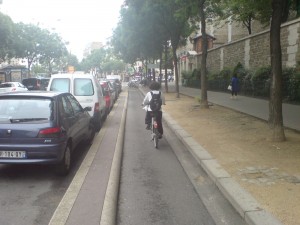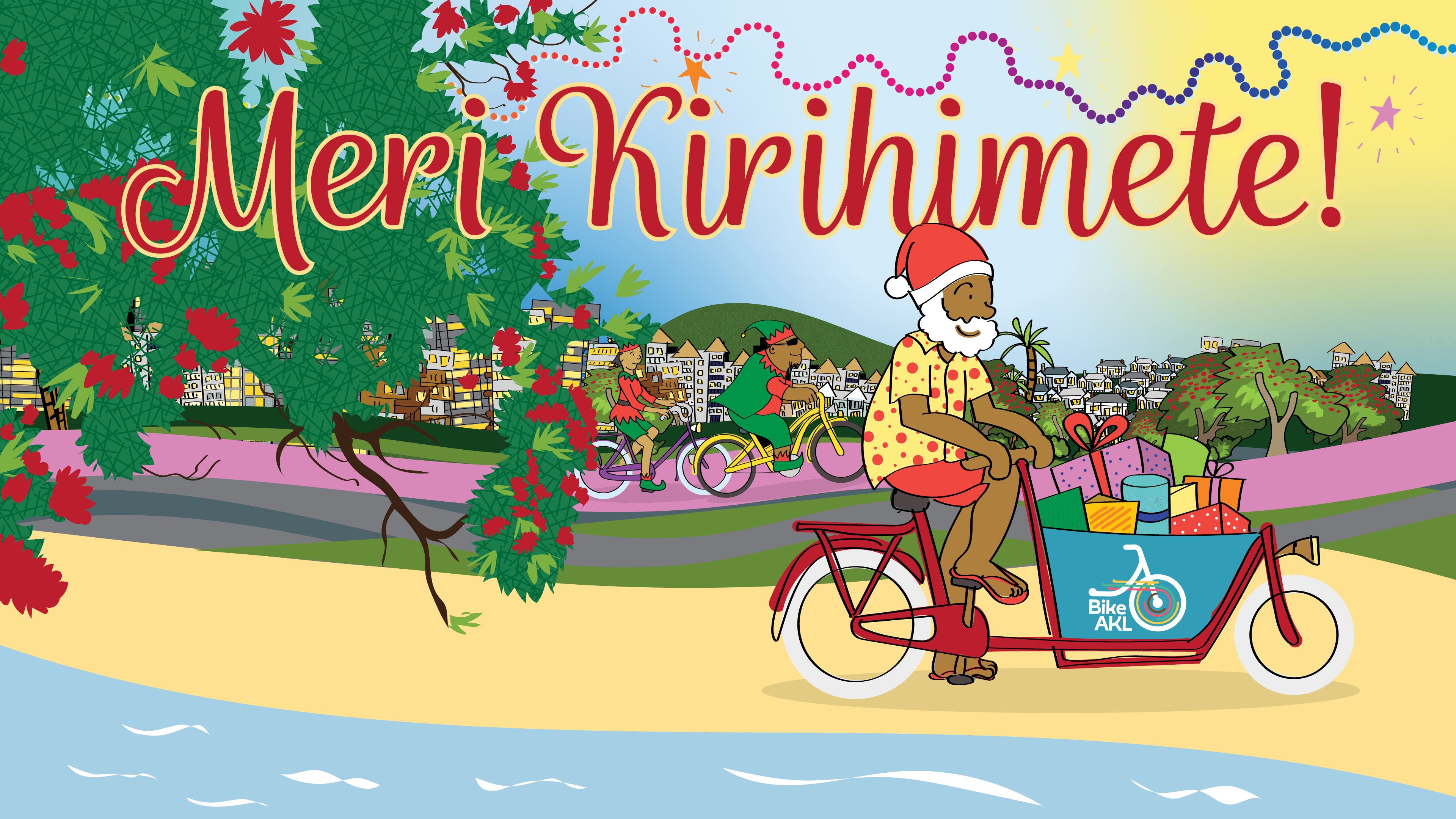[After a long absence, I got the chance to visit Europe again. Having become a cycling advocate in NZ in the meantime, I was keen to look closer at what I had previously taken for granted. In this series, I will talk about cycling in four cities I visited – Berlin, Warsaw, Paris and London.]
 PARIS
PARIS
First impressions: Oh gosh, cycling here is going to be stressful…
.
My first impression of cycling in central Paris were from a car window, arriving after a long trip from Germany. Entering Paris during the late rush hour, the narrow, busy multi-lane streets in the north-eastern suburbs we drove through were not inviting to cycling at all.
.
Soon however we saw the first of the many nice cycleways Paris has built in recent years – and almost as immediately the reason many of them have failed utterly: illegal parking.
.
If the roads are scary, and you can’t continue along a cycleway for more than 10-15m (!) without being forced back onto the street by some selfish moron treating a driveway crossing as a parking space, how can a city attract more cyclists? For all the many times I had visited Paris before, it was a sobering entry into the third city on our trip.
.
Perceived mode share: Cyclists are rare, maybe 3% or a small tad more (Auckland around 1-2%)
.
Contrary to the initial impressions, cyclist numbers in Paris are actually higher than Auckland, though not by much. Perceived cycle share in Paris also seemed to vary a lot, more so than in Berlin or Warsaw – on some streets, cyclists seem commonplace, in other areas, you go a long while without seeing any.
.
I did some quick googling, and it seems that Paris does indeed have around a 3% cycle share – having about doubled cycle traffic over the last decade. Of course, 3% is not really outstanding. For example, it only partially achieves the “safety in numbers” effect where cycle injuries drop markedly because motorists know to expect cyclists (around 5% most of that effect has been achieved).
.
Still, one doesn’t change such a large and complex city easily, so maybe it is unfair to expect Copenhagen-style effects so soon, especially as some pieces of the “cycle city” puzzle are clearly still missing (more on that below).
.
Much of the boost of the last years is generally ascribed to Velib, the Paris public hire bike service. Some studies estimate that as much as half of the gain came directly through the hire bikes (and the associated perception change – making cycling cooler and more visible), while the rest can likely be ascribed to other improvements Paris has made, for example in terms of cycleways.
.
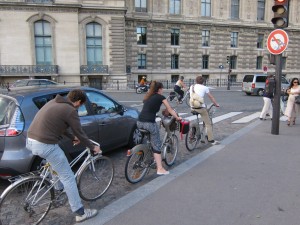 Typical cyclists (cycle style): Everyday folks
Typical cyclists (cycle style): Everyday folks.
I found Parisian cyclists more stylishly dressed than the average Warsovian, but not quite as stylish as the typical gents or ladies in Berlin. The Velib hire bike system certainly helps here too.
.
High-viz meanwhile was spotted at times, but only rarely. Maybe the ‘City of lights’ doesn’t need any extra illumination at night to see what is going on?
.
Cycle infrastructure: Cycle infrastructure is everywhere – and much of it doesn’t work
.
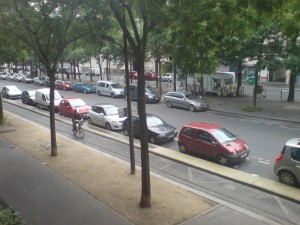
Paris is full of cycle infrastructure – ranging from cycle lanes painted onto everything from asphalt to cobblestones (!) to protected cycle lanes (nicely divided off from the general traffic with high concrete kerbing) to cycle paths on the sidewalk (generally divided clearly from pedestrians).
.
Also common are painted contra-flow cycle lanes in one-way streets, a cheap way of creating a more flexible network for cyclists. There are also numerous bus/cycle lanes, many of them also divided off from general traffic by concrete kerbing (though on a bus lane, this is a mixed blessing).
.

Cycle infrastructure is thus highly visible, and it is very commendable how much has been done in just the last 5 years or so.
.
Taking the example of the one-way streets, maybe 75% seem to have received contra-flow cycle lanes (I am not sure whether we have one contra-flow cycle lane in Auckland yet). Similarly, many main streets have received cycleways, and where streets are being (re)constructed, dedicated cycle facilities are very often included in the mix.
.
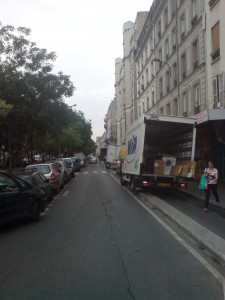
Why, then, with an infrastructure network that Auckland can only dream of at this stage, do they do so badly, comparatively speaking? The reason is, bluntly speaking, that traffic and parking laws are not enforced. And many Parisians abuse this, in a way Auckland cyclists would not believe.
.
I discussed the reasons for this with my father, who lives with his partner in one of the suburbs in the north – right on the edge between the better-off centre arrondissements and the outer banlieues, where many of the youths consider the police as enemies to be fought with, and where unrest and boredom can even erupt into full-on riots if things go really wrong.
.
So if the police turns up to tow your car, in most cities you risk getting letters to the editor decrying “revenue gathering” or “predatory towing”.
.

In Paris, you may risk more… spirited… protest when enforcing the law – and thus, the police simply don’t seem to bother anymore. Not worth the trouble for a few parking tickets, the state seems to have decided. Or maybe the cost-cutting in the police force has gotten so bad that they just can’t follow up such “minor” things anymore, being too busy keeping the lid on all the other troubles of a teeming city of millions.
.
But in any case the results are telling. Where nobody enforces the law, the law is moot. Every driveway is a parking space. Every cycleway is a parking lane. And every driveway across a cycle path is a particularly attractive spot, it seems. At that point, the kerb-protected cycle lanes especially become problematic: All you need is someone to park across the single entry or exit, and the kerb divider becomes a major hindrance, rather than something protecting you from traffic.
.
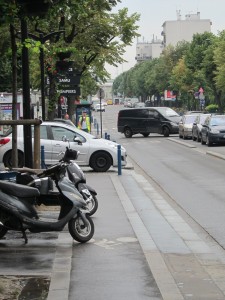
It’s quite clearly not an anti-
cycling thing. It’s just a total disregard for the rules and common decency. Heck, I have seen people parking in the
middle of an intersection. Just sitting there, traffic flowing around them more or less as it can. Bus lanes get parked across with the same impunity. Paris traffic really is a jungle.
.
I shouldn’t argue that all their work was in vain, though. The design of much of Paris cycle infrastructure is great. Riding along the protected cycle lanes, where they were un-blocked, was awesome – would love to get the same here in Auckland.
.
And they are obviously aware of their problems – as can be seen by the efforts they go in terms of putting up bollards, kerbs and other devices… to prevent drivers from using or parking in the cycle facilities.
.
But without enforcement, it’s all just a defensive battle that one cannot ever really win (so cheer the next time you see a parking warden – he’s helping you too!).
.
Public bike hire system: The leading light of all public bike hire systems, Velib is great, despite some growing pains
.
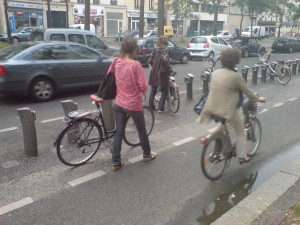
Paris pioneered the big-time hire bike concept with their
Velib system (though they were following in the footsteps of Lyon themselves). With 18,000 bikes and 1,200 stations, it is enormously comprehensive across the centre of Paris and the inner suburbs.
.
Paris seems full of Velib riders, dominating the public perception of cycling – even though, when one counts carefully, they actually do not make up quite as much of the bikes as it looks like.
.
The system has put its stamp on the city, and is in constant use, most of the riders being locals just “hopping on and off” for their next trip. I got the chance to try one for about an hour, and the bikes ride great, and the system is easy to use once you get over the typical sign-up hassle. More on that in a future post.
.
It is interesting however, that there’s still the old distribution problems – some stations in side streets would be chock-full of bikes, yet only a block or so down, there would be only 5 bikes left… all of them out of service. That other problem, damage and vandalism of bikes, still haunts the system – and has led to much larger subsidies being needed to keep it running than were originally forecast. A competitor system (foolishly allowed to be incompatible with Velib) has already ceased operation again in many areas.
.
But when they work fine (which probably applies to 90% of those 18,000 bikes at any one time) Velib is great, and it adds enormously to the city. Hopefully, we one day have the courage to spend our money here in the same way, rather than wasting it on more asphalt. Rental bikes provide “mobility choice” in a way cars just can’t in a congested city.
.
The verdict: So much effort, so much potential – and so much of it unrealised
.
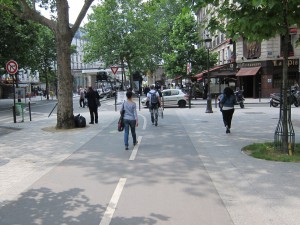
Having spent a good part of this article ranting, I think I should put it into perspective. As an example, my father’s partner rides pretty much everywhere in Paris, though she’s about as far from the “typical commuter cyclist” as can be.
.
But having lived in Paris pretty much all of her life, she knows how to behave and how things work (ironically, she found the first hour or so of cycling in Auckland quite scary – just goes to show).
.
Any city that wants to raise cycling strongly over a few years (rather than a few decades) will hit some major snags. For Auckland, that remains the difficulty to find the funds for infrastructure. For Paris, which has found the funds, it remains their unwillingness to say “enough” and enforce the traffic laws – which would be an enormous cultural change on its own.
.
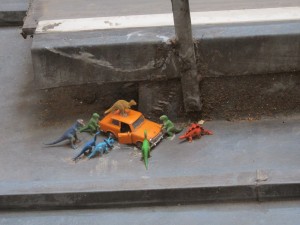
In the meantime, cycleways will remain under-used, and the Paris planners and engineers will need to continue to tinker around with physical methods of getting drivers off their cycleways*.
.
* (I like the “hunt them down with dinosaurs” option in the photo at the right – seen in the courtyard of the ‘Shakespeare & Company’ bookstore in the Quartier Latin).
.
For the time being, Parisian cyclists will have to remain flexible, their lot in that being not so different from Auckland cyclists.
 PARIS
PARIS Paris is full of cycle infrastructure – ranging from cycle lanes painted onto everything from asphalt to cobblestones (!) to protected cycle lanes (nicely divided off from the general traffic with high concrete kerbing) to cycle paths on the sidewalk (generally divided clearly from pedestrians).
Paris is full of cycle infrastructure – ranging from cycle lanes painted onto everything from asphalt to cobblestones (!) to protected cycle lanes (nicely divided off from the general traffic with high concrete kerbing) to cycle paths on the sidewalk (generally divided clearly from pedestrians). Cycle infrastructure is thus highly visible, and it is very commendable how much has been done in just the last 5 years or so.
Cycle infrastructure is thus highly visible, and it is very commendable how much has been done in just the last 5 years or so. Why, then, with an infrastructure network that Auckland can only dream of at this stage, do they do so badly, comparatively speaking? The reason is, bluntly speaking, that traffic and parking laws are not enforced. And many Parisians abuse this, in a way Auckland cyclists would not believe.
Why, then, with an infrastructure network that Auckland can only dream of at this stage, do they do so badly, comparatively speaking? The reason is, bluntly speaking, that traffic and parking laws are not enforced. And many Parisians abuse this, in a way Auckland cyclists would not believe. In Paris, you may risk more… spirited… protest when enforcing the law – and thus, the police simply don’t seem to bother anymore. Not worth the trouble for a few parking tickets, the state seems to have decided. Or maybe the cost-cutting in the police force has gotten so bad that they just can’t follow up such “minor” things anymore, being too busy keeping the lid on all the other troubles of a teeming city of millions.
In Paris, you may risk more… spirited… protest when enforcing the law – and thus, the police simply don’t seem to bother anymore. Not worth the trouble for a few parking tickets, the state seems to have decided. Or maybe the cost-cutting in the police force has gotten so bad that they just can’t follow up such “minor” things anymore, being too busy keeping the lid on all the other troubles of a teeming city of millions. It’s quite clearly not an anti-cycling thing. It’s just a total disregard for the rules and common decency. Heck, I have seen people parking in the middle of an intersection. Just sitting there, traffic flowing around them more or less as it can. Bus lanes get parked across with the same impunity. Paris traffic really is a jungle.
It’s quite clearly not an anti-cycling thing. It’s just a total disregard for the rules and common decency. Heck, I have seen people parking in the middle of an intersection. Just sitting there, traffic flowing around them more or less as it can. Bus lanes get parked across with the same impunity. Paris traffic really is a jungle. Paris pioneered the big-time hire bike concept with their Velib system (though they were following in the footsteps of Lyon themselves). With 18,000 bikes and 1,200 stations, it is enormously comprehensive across the centre of Paris and the inner suburbs.
Paris pioneered the big-time hire bike concept with their Velib system (though they were following in the footsteps of Lyon themselves). With 18,000 bikes and 1,200 stations, it is enormously comprehensive across the centre of Paris and the inner suburbs. Having spent a good part of this article ranting, I think I should put it into perspective. As an example, my father’s partner rides pretty much everywhere in Paris, though she’s about as far from the “typical commuter cyclist” as can be.
Having spent a good part of this article ranting, I think I should put it into perspective. As an example, my father’s partner rides pretty much everywhere in Paris, though she’s about as far from the “typical commuter cyclist” as can be. In the meantime, cycleways will remain under-used, and the Paris planners and engineers will need to continue to tinker around with physical methods of getting drivers off their cycleways*.
In the meantime, cycleways will remain under-used, and the Paris planners and engineers will need to continue to tinker around with physical methods of getting drivers off their cycleways*.
